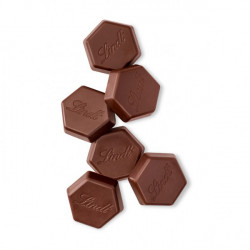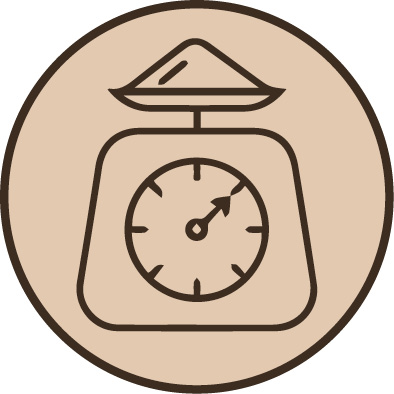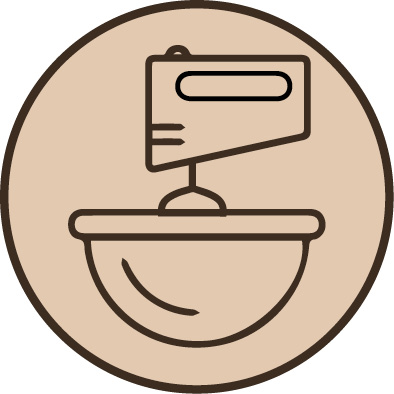...


If you stroll through the supermarket now, you will see chocolate moulds in all sorts of colours, shapes and sizes everywhere. Especially Father Christmas figures are currently indispensable - after all, it's high season. But in the supermarket you only find the classic shapes and buying your loved ones the same chocolate Santa every year is boring, isn't it? That's why we thought we'd show you how to make your own chocolate figures. In our online shop you will also find a very large selection of various chocolate moulds. We also explain the difference between fat-soluble powder colour and coloured cocoa butter and show you what you have to pay attention to if you want a perfectly cast mould.

5 min.

30 min.
40 min.
Tempered dark couverture
Tempered white couverture
Little cocoa butter, liquid
Fat soluble powder colour red
Tempered milk couverture
The most important thing when casting figures is that you polish the mould really well at the beginning so that the finished mould shines really nicely at the end. For polishing, it is best to take a paper towel and clean every part of the mould. Make sure that you get into the recesses so that they are also polished well. Now fill a cornet with tempered dark couverture, cut off a small tip and paint all the areas with the chocolate that are to be darkened. Always remember that the figure has a front and a back. Important: Paint the pupils of the figure first. People often forget that the make-up of such a figure is based on a layer system and that the eye is first filled with white couverture and then the pupil is painted afterwards. But this is wrong, because you don't see the pupil at all. You build up from the outside to the inside. Once you have filled all the areas of the mould that you want to be dark with dark couverture, let it dry for a short time. Wait about 5 minutes. Turn the mould over from time to time to make sure that you have coloured everything in properly, otherwise the colour of the chocolate that you will use to pour the final figure will show through later. Depending on the couverture you use, this may look less beautiful.
Once the chocolate is set, you can now colour in the light areas with the white couverture. Again, use a cornet with a small opening. Now you can also colour in the eye, as the pupil has already been painted. In this case it is also important that the bottom layer is already dry, otherwise it would melt and your figure would no longer have a pupil. Again, fill in all areas and let this layer dry as well.
Now the fat-soluble powder colour comes into play. Melt the cocoa butter carefully over a water bath. Do not heat the cocoa butter to more than 40 °C. Now pour the fat-soluble powder colour into a bowl. Depending on how intense you want the colouring to be, you may need to use more or less powder. Now add a small sip of the liquid cocoa butter to the powder colour in the bowl and stir until all the colour pigments have dissolved. Now you can add tempered white couverture and homogenise the mixture. Now fill in the areas that need to turn red.
The last colour that is missing now is the beige for the sledge. Simply mix very little tempered milk couverture with white tempered couverture, fill it again into a cornet and paint the polycarbonate figure with it. Allow this layer to dry for at least 5 but more likely 10 minutes. Then take a silicone brush (we advise you not to use hair brushes as they tend to lose hair and contaminate your figure) and brush the mould with tempered milk couverture. It is sufficient to paint only a very thin layer, the main purpose is to avoid air pockets. Also brush over the areas of the figure that have already been painted. Once you have painted both halves of the Father Christmas, you can use a metal horn to clean the edges of the figure. This step is very important because if you don't clean your mould properly, you may have problems or unsightly edges when you remove the chocolate figure.
Once you have removed the excess couverture from your mould, you can assemble it. Add a clamp to each side and one to the top. The clamps are a little tricky to put on, but they make sure that the two moulds stick together well. Now hold the mould at a slight angle above your tempering machine, take a ladle and fill the mould completely with the tempered couverture. Now tap the back of a spatula against the mould so that all the air bubbles rise to the top and the couverture is well and evenly distributed. Then turn the mould over and let all the chocolate run out of the Father Christmas mould again. Again, tap the mould so that the excess chocolate flows out and the walls of the chocolate figure are not too thick. Once the chocolate has flowed out, you can now run a spatula over the bottom of the edge to clean it and then put the mould in the fridge for about 5 minutes.
After the short cooling break, place a piece of baking paper on a cake tray and pour about a ladleful of tempered couverture onto it and spread it evenly with a spatula. Rub the palm of your hand 2-3 times over the bottom edge of the tin to warm the chocolate slightly and then place it on the just-smoothed couverture surface. Warming by hand is important as it helps the chocolate in the mould to bond better with the fresh surface, giving you a secure bond to the base that is sure not to fall off.
Place the mould in the fridge for another 5 minutes. After this time, be sure to remove the clamps and put the mould back in the fridge for at least 20 minutes. If you don't remove the clamps, there will be too much pressure on the mould and your hard-earned Father Christmas may break in the mould.
After the 20 minutes cooling time, you can now take a cast Santa out of the fridge. Rock the mould very gently, this will release the excess chocolate from the base and you will only have the chocolate where your mould is. Now carefully drive a spatula into the edge of the chocolate mould and go around once. During this process, air will get into the mould and your cast chocolate mould will almost release itself from the mould. All you have to do now is carefully pull one half of the mould backwards and then the other half. Would you like to do this with your child or would you like to see it live before you cast figures yourself at home? Then simply attend our Father Christmas casting course. Click here for our Father Christmas casting courses: https://www.minischoggi.ch/gb/courses/chocolate-courses/chocolate-santa-pouring/
If you now want to colour or sprinkle colour on pralines or chocolate bars, for example, or decorate them, we recommend using cocoa butter that has already been coloured. This has the advantage that it simply needs to be placed in warm water for a short time and is then immediately ready for use. The cocoa butter becomes very liquid and is therefore ideal for creating colourful sprinkles on moulds or for painting praline moulds. However, this liquid consistency can be your downfall when working with chocolate figures. If you try to paint the chocolate mould with a brush, the colour may run down and mix with your previous work, thus "soiling" it.
Therefore, we recommend that you use fat-soluble powder paint when working with chocolate figures. This is almost as viscous as pure couverture due to the added couverture and also ensures a colourful result thanks to the additional cocoa butter. For praline creations or chocolate bars, we would advise you not to use this colouring method, as you will not be able to create fine sprinkles due to the consistency.Colour gradients are also more difficult to create with this method and it is completely unsuitable for the airbrush method.

 Casting your own chocolate Easter bunnies
Casting your own chocolate Easter bunnies
 Make your own decor roulade
Make your own decor roulade
 Cinnamon star recipe
Cinnamon star recipe
 Correctly temper couverture and chocolate
Correctly temper couverture and chocolate
 Making Halloween chocolates
Making Halloween chocolates
Leave a comment